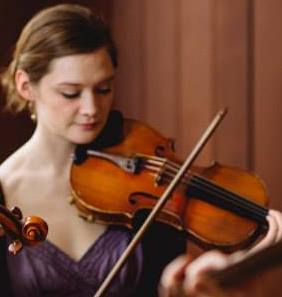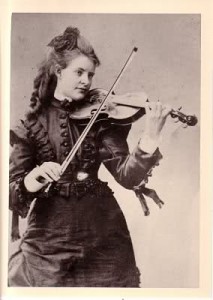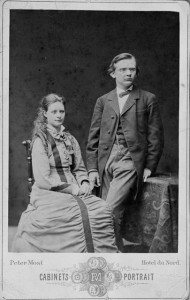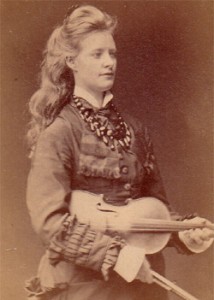Carol Cubberley, a freelance violinist in Boston, MA, became interested in uncovering music by women while at Boston Conservatory, and chose to play only music composed by women at her masters recital. In 2013 Carol was the violinist for the Apple Hill Festival fellowship trio and was a teaching assistant at Apple Hill in the summer of 2015. From 2012 to 2014 Carol participated in the nonprofit musiConnects as a member of the Sumner Quartet and as a violin teacher at the Chittick and Sumner elementary schools. During a residency at Avaloch Farm Music Institute in October 2015, Carol worked with composer Andy Costello on a piece he wrote for her and on Amanda Maier‘s Violin Sonata in b-minor. In November she played with The Cambridge Philharmonic Orchestra for their Women Composers Night concert. This spring Carol will teach an eight week class on Women Composers Through the Ages at the Cambridge Center for Adult Education. In March she will perform at the Women’s Studies Research Center at Brandeis University, and at the Women Composers Festival of Hartford.
Conservatory, and chose to play only music composed by women at her masters recital. In 2013 Carol was the violinist for the Apple Hill Festival fellowship trio and was a teaching assistant at Apple Hill in the summer of 2015. From 2012 to 2014 Carol participated in the nonprofit musiConnects as a member of the Sumner Quartet and as a violin teacher at the Chittick and Sumner elementary schools. During a residency at Avaloch Farm Music Institute in October 2015, Carol worked with composer Andy Costello on a piece he wrote for her and on Amanda Maier‘s Violin Sonata in b-minor. In November she played with The Cambridge Philharmonic Orchestra for their Women Composers Night concert. This spring Carol will teach an eight week class on Women Composers Through the Ages at the Cambridge Center for Adult Education. In March she will perform at the Women’s Studies Research Center at Brandeis University, and at the Women Composers Festival of Hartford.
As a violin student I did not play a piece by a woman composer until about three years ago, while I was in graduate school. Growing up, I had assumed that significant women composers were basically non-existent until the 20th century. In my music history classes, the only women composers mentioned were Hildegard von Bingen and a few contemporary composers. Finally, while studying for my master’s degree at Boston Conservatory I took a music history class with Prof. Rebecca Marchand, who made a point of including at least one significant woman composer from each era. I then realized, it was not that they didn’t exist, but rather that they had simply not been included in the history books or passed down as standard repertoire. I decided, since in the past I had only ever played pieces by male composers, that for my master’s recital I would only play pieces composed by women. I had a wonderful time researching and beginning to discover some of the beautiful and varied violin repertoire written by women throughout history.
One of my favorite discoveries was Swedish composer Amanda Maier (1853-1894 — whose birthday is February 19!).  Nearly forgotten until around 1994, Maier was a well known and popular composer in her prime. She was born to a working-class family living in Landskrona, Sweden. Her father was a baker but also an amateur musician and Maier’s first violin and piano teacher. At age 16, she enrolled in the Stockholm Conservatory of Music with a course of study including violin, cello, piano, organ, composition, and harmony. She was the first female to earn a degree from the school and she also won awards for her violin, cello, and organ playing, as well as for her compositions.
Nearly forgotten until around 1994, Maier was a well known and popular composer in her prime. She was born to a working-class family living in Landskrona, Sweden. Her father was a baker but also an amateur musician and Maier’s first violin and piano teacher. At age 16, she enrolled in the Stockholm Conservatory of Music with a course of study including violin, cello, piano, organ, composition, and harmony. She was the first female to earn a degree from the school and she also won awards for her violin, cello, and organ playing, as well as for her compositions.
After graduating she moved to Leipzig, Germany where she studied violin with Engelbert Rontgen and composition with Carl Reinecke. During this time she composed her Violin Sonata in B minor, a Piano Trio, and a Violin Concerto. In 1877 the Musikaliska Konstföreningen (the Swedish Art Music Society) accepted Maier’s Violin Sonata for publication, but wanted to alter the slow movement. In her response Maier shows her confidence as a composer: “I have become so much a part of it as it stands that I would quite certainly have difficulty in making any changes […]. So I would prefer if the Sonata could be left unaltered.” Yielding to her wishes the Society published her sonata without any alterations. Playing a Stradivarius that had been loaned to her, she premiered her Violin Concerto with the Leipzig Gewandhaus Orchestra under the baton of her composition teacher, Carl Reinecke. The concerto was received with great enthusiasm, and was performed over 37 times between 1876 and 1879, an impressive record.

Amanda with Julius Röntgen
Maier toured all over Europe and eventually was joined by her violin teacher’s son, Julius Röntgen, who was also a pianist and composer. The pair performed standard repertoire alongside Maier’s compositions, most likely including her B-minor Violin Sonata. Their collaboration grew to more than just a friendship, and in 1880, the same year Julius’s father passed away, they were married.
At this point Maier had written (in addition to the pieces mentioned earlier) 25 Preludes for piano, a piece for piano and cello, a few songs, six pieces for violin and piano, two string quartets, and a variety of other instrumental works. Although Maier quit performing publicly after she and Röntgen were married, they did host regular musical salons in their home, welcoming such luminaries as Johannes Brahms, Arthur Rubinstein, and Edvard Grieg. Brahms became an admirer of Maier’s work. He sought her advice for his third Violin Sonata and chose to include her revisions in his final edition. Grieg, a fellow student of Maier’s in Leipzig, said that he had “always been an admirer of her talent.” Maier was diagnosed with tuberculosis in 1887, after the birth of her second son. Her last composition was a Piano Quartet that she wrote in 1891 with the help of her husband because her eyesight was failing. She was only 41 years old when she passed away in 1894.
In recent years, there has been a revival of interest in Maier’s compositions. Gregory Maytan’s 2009 CD includes her Violin Sonata and was chosen as “CD of the Month” by The Strad Magazine, which enthused “the real discovery here” is Maier’s Violin Sonata, an “inexplicably neglected score.” Maytan was introduced to Maier’s music when he was a young student in Northern Sweden; however, when Maytan performed Maier’s B minor Violin Sonata at the Royal University of Music in Stockholm, he was surprised to find that the work was virtually unknown there. He has also recorded her Six Pieces for Violin and Piano and has just recorded her Violin Concerto. Her concerto was recently made available for the first time in the US and in May was performed by Claudia Bonfiglioli with the Royal Stockholm Philharmonic Orchestra. This video is an amazing performance, and if her Concerto reminds you of Brahms’ concerto for Violin, keep in mind that hers was composed three years before his.
For more information about Amanda Maier I recommend reading this blog post from “Unjustly Neglected Composers.” It is exciting that her music is being rediscovered, and as more people hear recordings and performances of her Violin Sonata and Violin Concerto I would not be surprised if these works and others by her soon find their way into the standard repertoire.
